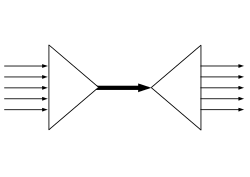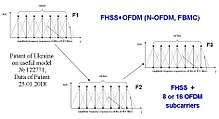Frequency-hopping spread spectrum
| Passband modulation |
|---|
| Analog modulation |
| Digital modulation |
| Hierarchical modulation |
| Spread spectrum |
| See also |
|
| Multiplexing |
|---|
 |
| Analog modulation |
| Related topics |
Frequency-hopping spread spectrum (FHSS) is a method of transmitting radio signals by rapidly switching a carrier among many frequency channels, using a pseudorandom sequence known to both transmitter and receiver. It is used as a multiple access method in the code division multiple access (CDMA) scheme frequency-hopping code division multiple access (FH-CDMA).
Each available frequency band is divided into sub-frequencies. Signals rapidly change ("hop") among these in a predetermined order. Interference at a specific frequency will only affect the signal during that short interval. FHSS can, however, cause interference with adjacent direct-sequence spread spectrum (DSSS) systems.
A sub-type of FHSS used in Bluetooth wireless data transfer is adaptive frequency-hopping spread spectrum (AFH).
Spread-spectrum
A spread-spectrum transmission offers three main advantages over a fixed-frequency transmission:
- Spread-spectrum signals are highly resistant to narrowband interference. The process of re-collecting a spread signal spreads out the interfering signal, causing it to recede into the background.
- Spread-spectrum signals are difficult to intercept. A spread-spectrum signal may simply appear as an increase in the background noise to a narrowband receiver. An eavesdropper may have difficulty intercepting a transmission in real time if the pseudorandom sequence is not known.
- Spread-spectrum transmissions can share a frequency band with many types of conventional transmissions with minimal interference. The spread-spectrum signals add minimal noise to the narrow-frequency communications, and vice versa. As a result, bandwidth can be used more efficiently.
Military use
Spread-spectrum signals are highly resistant to deliberate jamming, unless the adversary has knowledge of the spreading characteristics. Military radios use cryptographic techniques to generate the channel sequence under the control of a secret Transmission Security Key (TRANSEC) that the sender and receiver share in advance.
By itself, frequency hopping provides only limited protection against eavesdropping and jamming. Most modern military frequency hopping radios also employ separate encryption devices such as the KY-57 Speech Security Equipment. U.S. military radios that use frequency hopping include the JTIDS/MIDS family, the HAVE QUICK Aeronautical Mobile (OR) communications system, and the SINCGARS Combat Net Radio, Link-16.
Civilian use
In the US, since the Federal Communications Commission (FCC) amended rules to allow frequency hopping spread spectrum systems in the unregulated 2.4 GHz band, many consumer devices in that band have employed various spread-spectrum modes.
Some walkie-talkies that employ frequency-hopping spread spectrum technology have been developed for unlicensed use on the 900 MHz band. Several such radios were marketed under the name eXtreme Radio Service (eXRS). Despite the name's similarity to the FRS allocation, the system is a proprietary design, rather than an official FCC allocated service.
Frequency-hopping spread spectrum technology is also used in many hobby RC (radio controlled) transmitters and receivers used for model cars, airplanes, and drones. A type of multiple access is achieved allowing hundreds of transmitter/receiver pairs to be operated simultaneously on the same band in contrast to previous FM or AM RC systems that had limited simultaneous channels.[1]
Motorola has deployed a business-banded, license-free digital radio that uses FHSS technology: the DTR series, models 410, 550 and 650.
Technical considerations
The overall bandwidth required for frequency hopping is much wider than that required to transmit the same information using only one carrier frequency. However, because transmission occurs only on a small portion of this bandwidth at any given time, the effective interference bandwidth is really the same. While providing no extra protection against wideband thermal noise, the frequency-hopping approach does reduce the degradation caused by narrowband interference sources.
One of the challenges of frequency-hopping systems is to synchronize the transmitter and receiver. One approach is to have a guarantee that the transmitter will use all the channels in a fixed period of time. The receiver can then find the transmitter by picking a random channel and listening for valid data on that channel. The transmitter's data is identified by a special sequence of data that is unlikely to occur over the segment of data for this channel, and the segment can also have a checksum for integrity checking and further identification. The transmitter and receiver can use fixed tables of channel sequences, so that once synchronized they can maintain communication by following the table. On each channel segment, the transmitter can send its current location in the table.
In the US, FCC part 15 on unlicensed spread spectrum systems in the 902–928 MHz and 2.4 GHz bands permits more power than is allowed for non-spread-spectrum systems. Both frequency hopping and direct sequence systems can transmit at 1 Watt, a thousand-fold increase from the 1 milliwatt limit on non-spread-spectrum systems. The Federal Communications Commission (FCC) also prescribes a minimum number of channels and a maximum dwell time for each channel.
In a real multipoint spread spectrum radio system, space allows the possibility of multiple transmissions on the same frequency using multiple radios in a geographic area. This creates the possibility of system data rates that are higher than the Shannon limit for a single channel. Spread spectrum systems do not violate the Shannon limit. Spread spectrum systems rely on excess signal to noise ratios for sharing of spectrum. This property is also seen in MIMO and DSSS systems. Beam steering and directional antennas also facilitate increased system performance by providing isolation between remote radios.
Multiple inventors
In 1899 Guglielmo Marconi experimented with frequency-selective reception in an attempt to minimise interference.[2]
The earliest mentions of frequency hopping in the open literature are in US patent 725,605 awarded to Nikola Tesla in March 17, 1903 and in radio pioneer Jonathan Zenneck's book Wireless Telegraphy (German, 1908, English translation McGraw Hill, 1915), although Zenneck himself states that Telefunken had already tried it. Nikola Tesla doesn’t mention the phrase “frequency hopping” directly, but certainly alludes to it. Entitled Method of Signaling, the patent describes a system that would enable radio communication without any danger of the signals or messages begin disturbed, intercepted, interfered with in any way [3].
The German military made limited use of frequency hopping for communication between fixed command points in World War I to prevent eavesdropping by British forces, who did not have the technology to follow the sequence.[4]
A Polish engineer and inventor, Leonard Danilewicz, came up with the idea in 1929.[5] Several other patents were taken out in the 1930s, including one by Willem Broertjes (U.S. Patent 1,869,659, issued Aug. 2, 1932).
During World War II, the US Army Signal Corps was inventing a communication system called SIGSALY, which incorporated spread spectrum in a single frequency context. However, SIGSALY was a top-secret communications system, so its existence did not become known until the 1980s.
The most celebrated use of frequency hopping was a patent awarded to actress Hedy Lamarr and composer George Antheil, who in 1942 received U.S. Patent 2,292,387 for their "Secret Communications System". This intended early version of frequency hopping was supposed to use a piano-roll to change among 88 frequencies, and was intended to make radio-guided torpedoes harder for enemies to detect or to jam, but there is no record of a working device ever being produced. The patent was rediscovered in the 1950s during patent searches when private companies independently developed Code Division Multiple Access, a non-frequency-hopping form of spread-spectrum, and has been cited numerous times since.
A practical application of frequency hopping was developed by Ray Zinn, co-founder of Micrel Corporation. Zinn developed a method allowing radio devices to operate without the need to synchronize a receiver with a transmitter. Using frequency hopping and sweep modes, Zinn's method is primarily applied in low data rate wireless applications such as utility metering, machine and equipment monitoring and metering, and remote control. In 2006 Zinn received U.S. Patent 6,996,399 for his "Wireless device and method using frequency hopping and sweep modes."
Variations
Adaptive frequency-hopping spread spectrum (AFH; as used in Bluetooth) improves resistance to radio frequency interference by avoiding crowded frequencies in the hopping sequence. This sort of adaptive transmission is easier to implement with FHSS than with DSSS.
The key idea behind AFH is to use only the “good” frequencies, by avoiding the "bad" frequency channels—perhaps those "bad" frequency channels are experiencing frequency selective fading, or perhaps some third party is trying to communicate on those bands, or perhaps those bands are being actively jammed. Therefore, AFH should be complemented by a mechanism for detecting good/bad channels.
However, if the radio frequency interference is itself dynamic, then the strategy of “bad channel removal”, applied in AFH might not work well. For example, if there are several colocated frequency-hopping networks (as Bluetooth Piconet), then they are mutually interfering and the strategy of AFH fails to avoid this interference.
The problem of dynamic interference, gradual reduction of available hopping channels and backward compatibility with legacy bluetooth devices was resolved in version 1.2 of the Bluetooth Standard (2003). Other strategies for dynamic adaptation of the frequency hopping pattern have been reported in the literature.[6] Such a situation can often happen in the scenarios that use unlicensed spectrum.
In addition, dynamic radio frequency interference is expected to occur in the scenarios related to cognitive radio, where the networks and the devices should exhibit frequency-agile operation.
Chirp modulation can be seen as a form of frequency-hopping that simply scans through the available frequencies in consecutive order to communicate.
The other concept also can use the combination of frequency hopping spread spectrum with OFDM or non-orthogonal frequency-division multiplexing (N-OFDM) of signals. It can increase data performance.[7]
See also
Notes
- ↑ "Most RC model aircraft airborne simultaneously". Guinness World Records. Retrieved 2018-02-16.
- ↑ https://books.google.co.uk/books?id=35ClAgAAQBAJ&pg=PA158&lpg=PA158&dq=Marconi+1899+"Frequency-Selective"&source=bl&ots=OS5QiNlwU2&sig=y30NftAXUC3E1_J8nCFKjAjB4oo&hl=en&sa=X&ved=0ahUKEwi7jIPJwLTXAhVQ4KQKHTvaBTwQ6AEIKDAA#v=onepage&q=Marconi%201899%20%22Frequency-Selective%22&f=false
- ↑ eetimes.com: A short history of spread spectrum
- ↑ Denis Winter, Haig's Command - A Reassessment
- ↑ Danilewicz later recalled: "In 1929 we proposed to the General Staff a device of my design for secret radio telegraphy which fortunately did not win acceptance, as it was a truly barbaric idea consisting in constant changes of transmitter frequency. The commission did, however, see fit to grant me 5,000 złotych for executing a model and as encouragement to further work." Cited in Władysław Kozaczuk, Enigma: How the German Machine Cipher Was Broken, and How It Was Read by the Allies in World War II, 1984, p. 27.
- ↑ Petar Popovski; Hiroyuki Yomo; Ramjee Prasad (December 2006). "Strategies For Adaptive Frequency Hopping In The Unlicensed Bands" (PDF). IEEE Wireless Communications. Archived from the original (PDF) on 2009-02-27. Retrieved 2008-03-02.
- 1 2 Патент Украины на полезную модель № 122771. МПК H04B 3/60 (2006.01), H04B 1/58 (2006.01), H04B 1/56 (2006.01). Способ повышения скорости передачи данных сигналами с псевдослучайной перестройкой частоты./ Слюсар В.И.- Заявка на выдачу патента Украины на полезную модель № u201707800 от 25.07.2017.- Патент опубл. 25.01.2018, бюл. № 2.
References
- Władysław Kozaczuk, Enigma: How the German Machine Cipher Was Broken, and How It Was Read by the Allies in World War Two, edited and translated by Christopher Kasparek, Frederick, MD, University Publications of America, 1984, ISBN 0-89093-547-5.
External links
- FCC Part 15 Rules that cover frequency hopping
- Frequency hopping in unlicensed spectrum describes strategies for adaptive hopping in crowded spectrum, while considering the issues of radio etiquette and compliance with FCC Part 15 Rules
